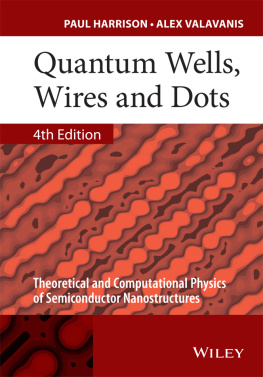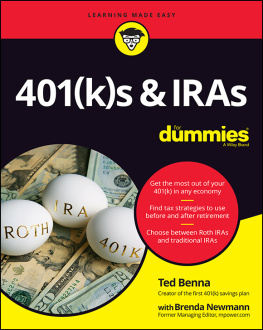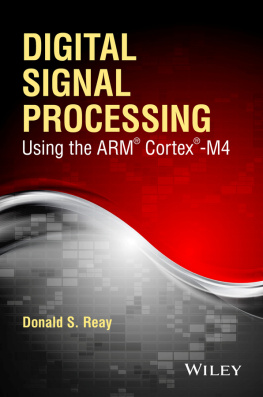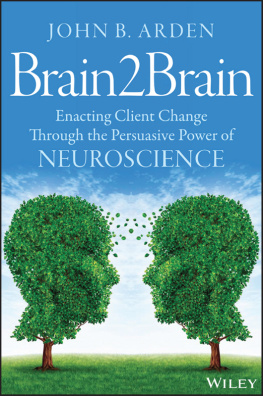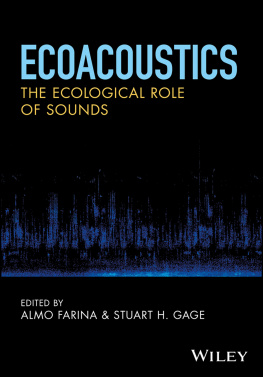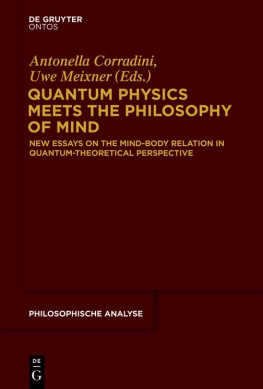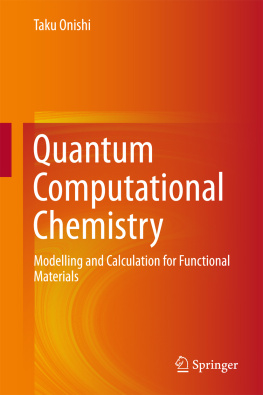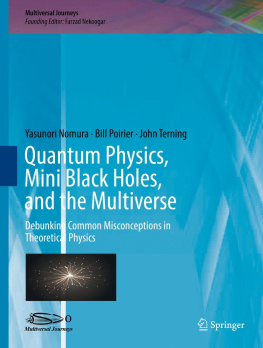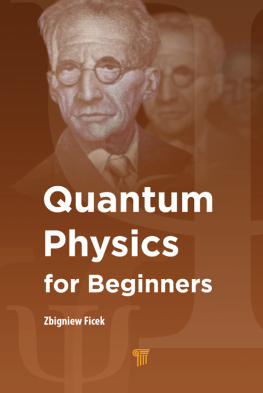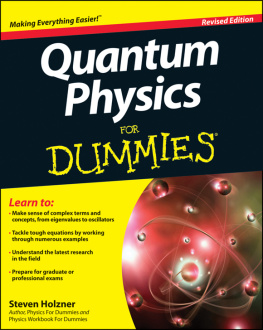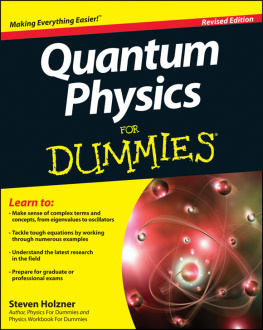John Wiley - Quantum wells, wires and dots: theoretical and computational physics of semiconductor nanostructures
Here you can read online John Wiley - Quantum wells, wires and dots: theoretical and computational physics of semiconductor nanostructures full text of the book (entire story) in english for free. Download pdf and epub, get meaning, cover and reviews about this ebook. City: Chichester, year: 2016, publisher: John Wiley & Sons, Incorporated, genre: Home and family. Description of the work, (preface) as well as reviews are available. Best literature library LitArk.com created for fans of good reading and offers a wide selection of genres:
Romance novel
Science fiction
Adventure
Detective
Science
History
Home and family
Prose
Art
Politics
Computer
Non-fiction
Religion
Business
Children
Humor
Choose a favorite category and find really read worthwhile books. Enjoy immersion in the world of imagination, feel the emotions of the characters or learn something new for yourself, make an fascinating discovery.
- Book:Quantum wells, wires and dots: theoretical and computational physics of semiconductor nanostructures
- Author:
- Publisher:John Wiley & Sons, Incorporated
- Genre:
- Year:2016
- City:Chichester
- Rating:3 / 5
- Favourites:Add to favourites
- Your mark:
- 60
- 1
- 2
- 3
- 4
- 5
Quantum wells, wires and dots: theoretical and computational physics of semiconductor nanostructures: summary, description and annotation
We offer to read an annotation, description, summary or preface (depends on what the author of the book "Quantum wells, wires and dots: theoretical and computational physics of semiconductor nanostructures" wrote himself). If you haven't found the necessary information about the book — write in the comments, we will try to find it.
Quantum wells, wires and dots: theoretical and computational physics of semiconductor nanostructures — read online for free the complete book (whole text) full work
Below is the text of the book, divided by pages. System saving the place of the last page read, allows you to conveniently read the book "Quantum wells, wires and dots: theoretical and computational physics of semiconductor nanostructures" online for free, without having to search again every time where you left off. Put a bookmark, and you can go to the page where you finished reading at any time.
Font size:
Interval:
Bookmark:

This edition first published 2016
2016 John Wiley & Sons, Ltd
Registered office
John Wiley & Sons Ltd, The Atrium, Southern Gate, Chichester, West Sussex, PO19 8SQ, United Kingdom
For details of our global editorial offices, for customer services and for information about how to apply for permission to reuse the copyright material in this book please see our website at www.wiley.com.
The right of the authors to be identified as the author of this work has been asserted in accordance with the Copyright, Designs and Patents Act 1988.
All rights reserved. No part of this publication may be reproduced, stored in a retrieval system, or transmitted, in any form or by any means, electronic, mechanical, photocopying, recording or otherwise, except as permitted by the UK Copyright, Designs and Patents Act 1988, without the prior permission of the publisher.
Wiley also publishes its books in a variety of electronic formats. Some content that appears in print may not be available in electronic books.
Designations used by companies to distinguish their products are often claimed as trademarks. All brand names and product names used in this book are trade names, service marks, trademarks or registered trademarks of their respective owners. The publisher is not associated with any product or vendor mentioned in this book.
Limit of Liability/Disclaimer of Warranty: While the publisher and authors have used their best efforts in preparing this book, they make no representations or warranties with respect to the accuracy or completeness of the contents of this book and specifically disclaim any implied warranties of merchantability or fitness for a particular purpose. It is sold on the understanding that the publisher is not engaged in rendering professional services and neither the publisher nor the authors shall be liable for damages arising herefrom. If professional advice or other expert assistance is required, the services of a competent professional should be sought.
The advice and strategies contained herein may not be suitable for every situation. In view of ongoing research, equipment modifications, changes in governmental regulations, and the constant flow of information relating to the use of experimental reagents, equipment, and devices, the reader is urged to review and evaluate the information provided in the package insert or instructions for each chemical, piece of equipment, reagent, or device for, among other things, any changes in the instructions or indication of usage and for added warnings and precautions. The fact that an organization or website is referred to in this work as a citation and/or a potential source of further information does not mean that the authors or the publisher endorses the information the organization or website may provide or recommendations it may make. Further, readers should be aware that Internet websites listed in this work may have changed or disappeared between when this work was written and when it is read. No warranty may be created or extended by any promotional statements for this work. Neither the publisher nor the authors shall be liable for any damages arising herefrom.
Library of Congress Cataloging-in-Publication Data
Names: Harrison, P. (Paul), author. | Valavanis, Alex, author.
Title: Quantum wells, wires and dots : theoretical and computational physics of semiconductor nanostructures / Paul Harrison (Sheffield Hallam University, UK), Alex Valavanis (The University of Leeds, UK).
Description: Fourth edition. | West Sussex, United Kingdom; Hoboken, NJ :
John Wiley & Sons, Inc., 2016. | 2016 | Includes bibliographical references and index.
Identifiers: LCCN 2015038317 (print) | LCCN 2015045402 (ebook) | ISBN 9781118923368 (cloth) | ISBN 1118923367 (cloth) | ISBN 9781118923351 (pdf) | ISBN 9781118923344 (epub)
Subjects: LCSH: Quantum wells. | Nanowires. | Quantum dots.
Classification: LCC QC176.8.Q35 H37 2016 (print) | LCC QC176.8.Q35 (ebook) |
DDC 537.6/226-dc23
LC record available at http://lccn.loc.gov/2015038317
A catalogue record for this book is available from the British Library.
ISBN: 9781118923368
To our families
Paul Harrison developed much of his input to this text through periods at the University of Newcastle as a postgraduate research student, the University of Hull as a postdoctoral research assistant and then at the University of Leeds where he eventually became Professor of Quantum Electronics. Paul is now Pro Vice-Chancellor for Research and Innovation at Sheffield Hallam University, UK. He can always be found on the web and always answers e-mail. Currently he can be reached at:
p.harrison@shu.ac.uk or p.harrison@physics.orgPaul continues to be involved in a variety of projects, most of which centre around exploiting quantum mechanics for the creation of novel optoelectronic devices, largely, but not exclusively, in semiconductor Quantum Wells, Wires and Dots.
Alex Valavanis is a research fellow in the Institute of Microwaves and Photonics (IMP) at the University of Leeds, UK. He has published extensively on the theory and design of semiconductor nanostructures, and now works in the Terahertz Photonics Laboratory on the experimental development of terahertz imaging and sensor systems. His research interests include quantum cascade lasers, silicongermanium optoelectronics, band-structure and carrier transport effects in semiconductor heterostructures, numerical methods and terahertz photonics. He can be contacted at:
a.valavanis@leeds.ac.ukZoran Ikoni is Reader in Photonics and Plasmonics in the School of Electronic and Electrical Engineering at the University of Leeds. His research interests and experience include the full width of semiconductor physics and optoelectronic devices, in particular, band-structure calculations, strain-layered systems, carrier scattering theory, nonlinear optics, as well as conventional and quantum mechanical methods for device optimisation.
Vladimir Jovanovi completed his PhD in the IMP on physical models of quantum well infrared photodetectors and quantum cascade lasers in GaN- and GaAs-based materials for near-, mid- and far-infrared (terahertz) applications.
Marco Califano is a Royal Society University Research Fellow based in the IMP at Leeds whose main interests focus on atomistic pseudo-potential modelling of the electronic and optical properties of semiconductor nanostructures of different materials for applications in photovoltaics.
Craig A. Evans completed his PhD on the optical and thermal properties of quantum cascade lasers in the School of Electronic and Electrical Engineering, University of Leeds, in 2008. He then worked as a postdoctoral research assistant in the IMP in the field of rare-earth doped fibre lasers and integrated photonic device modelling and has now joined the staff of the school.
Dragan Indjin is Reader in Optoelectronics and Nanoscale Electronics in the School of Electronic and Electrical Engineering at the University of Leeds. He has research interests in semiconductor nanostructures, nonlinear optics, quantum computing and spintronics.
Andrew Grier completed his PhD in the School of Electronic and Electrical Engineering at the University of Leeds in 2015. His research interests include band-structure and transport calculations in quantum cascade lasers and GaN-based intersubband devices.
I have been working on theoretical and computational studies of the electronic, optical and magnetic properties of semiconductor heterostructures for two decades. During this time I have had to follow through various theoretical derivations from either books or research papers and frankly I've struggled time and time again. There never seems to be enough detail and what is commonly a couple of lines in a research paper can literally turn into many pages of precise mathematics.
Next pageFont size:
Interval:
Bookmark:
Similar books «Quantum wells, wires and dots: theoretical and computational physics of semiconductor nanostructures»
Look at similar books to Quantum wells, wires and dots: theoretical and computational physics of semiconductor nanostructures. We have selected literature similar in name and meaning in the hope of providing readers with more options to find new, interesting, not yet read works.
Discussion, reviews of the book Quantum wells, wires and dots: theoretical and computational physics of semiconductor nanostructures and just readers' own opinions. Leave your comments, write what you think about the work, its meaning or the main characters. Specify what exactly you liked and what you didn't like, and why you think so.

